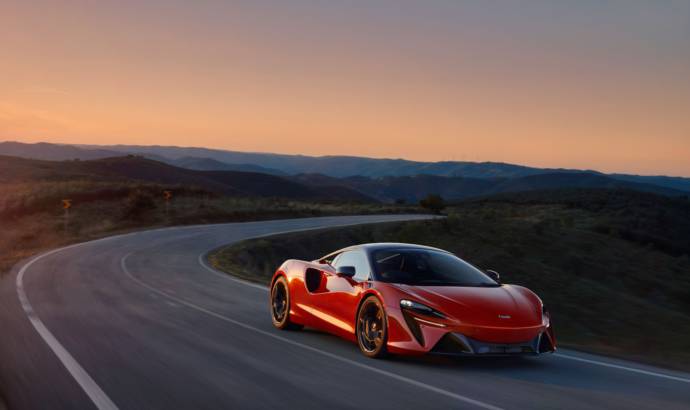After the P1, Mclaren started to launch more and more hybrid models. The new Artura is the best example of McLaren’s intentions.
Minimising weight was key to the design of the all-new powertrain. This is hugely important in an electrified supercar, as well as being absolutely aligned with McLaren’s philosophy of super-lightweight engineering that is fundamental to the performance, agility and driver engagement inherent in every McLaren.
Breaking with the V8 convention established with the first supercar from McLaren Automotive, the 12C, at the heart of the Artura is an all-new, 3.0-litre V6 internal combustion engine. The 120-degree, twin-turbocharged M630 unit not only delivers unrivalled performance, it also allows the most compact packaging possible. A 180-degree angle was considered but dismissed because it would raise the height of the crankshaft and therefore the centre of gravity of the car. The wide angle of the V6 cylinders allows the turbochargers to sit within the banks in a ‘hot vee’ configuration, which also benefits efficiency as they sit within a straighter – and therefore less restrictive – exhaust layout. Generating 585PS and 585Nm of torque, the all-new V6 engine is 190mm shorter and 220mm narrower than McLaren’s twin-turbo 4.0-litre V8 – and also 50kg lighter.
While the configuration of the all-new engine is key to the Artura’s powertrain packaging, it is the innovative technology within that provides the biggest gains in lightweighting and performance. The cylinder head and block utilise 3D printed cores, allowing uncompromised precision cooling, including a micro-compact 2mm cooling passage between the cylinders. The block has directly coated parent bores rather than separate coated liners, into which fuel is injected at 350bar pressure.
The Artura’s V6 engine is designed not just for compact packaging and efficiency, but also to increase driver engagement. Shared crank pins enable a very short and stiff crankshaft that allows the M630 to redline at a thrilling 8500rpm. It’s also a very refined engine, designed with the chain drive at the rear and with ancillary noises reduced so that the occupants only hear the V6’s distinctive intake and exhaust note, routed via Gasoline Particulate Filters to reduce emissions.
The V6 engine powers the rear wheels via an all-new eight-speed seamless shift transmission that has also been design for optimised packaging. The length of the gear cluster has been reduced by 40mm, helped by use of a nested clutch rather than a parallel unit and also the removal of a reverse gear, this function now achieved by the Artura’s E-motor spinning in the opposite direction. The ultra-compact motor is fully integrated within the transmission bell-housing, delivering torque in-fill and linear acceleration via an E-differential to the rear wheels.
Providing the electric-only capability is a 7.4kWh Five-module Lith ium Ion energy dense battery pack. Fully-integrated into the Artura’s McLaren Lightweight Architecture (MCLA) chassis, the battery pack is positioned low-down in the car behind the driver, incorporated into the floor and protected on three sides by the main carbon fibre structure and from behind by the engine. This positioning also helps to optimise both centre of gravity and the polar moment of inertia, benefitting dynamic agility.
The hybrid battery sits on a cooling manifold, which is shared with the new electric heating, ventilation and air conditioning system also used to control air temperature in the cabin. Incorporating technology first developed for the McLaren Speedtail, the batteries are thermally controlled using dielectric oil – a technology also used to keep the E-motor at operating temperatures that deliver the highest level of performance.





